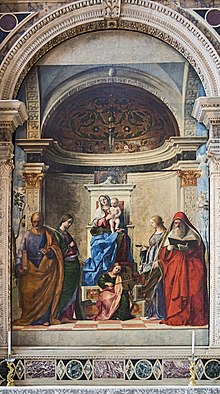
Back رسم فينيسي Arabic Венецыянская школа жывапісу Byelorussian Вэнэцыянская школа жывапісу BE-X-OLD Венецианска школа Bulgarian Escola veneciana de pintura Catalan Benátská škola Czech Den venetianske skole i maleriet Danish Venezianische Malerei German Βενετική Σχολή Greek Escuela veneciana Spanish

Venetian painting was a major force in Italian Renaissance painting and beyond. Beginning with the work of Giovanni Bellini (c. 1430–1516) and his brother Gentile Bellini (c. 1429–1507) and their workshops, the major artists of the Venetian school included Giorgione (c. 1477–1510), Titian (c. 1489–1576), Tintoretto (1518–1594), Paolo Veronese (1528–1588) and Jacopo Bassano (1510–1592) and his sons. Considered to give primacy to colour over line,[1] the tradition of the Venetian school contrasted with the Mannerism prevalent in the rest of Italy. The Venetian style exerted great influence upon the subsequent development of Western painting.[2]

By chance, the main phases of Venetian painting fit rather neatly into the centuries. The glories of the 16th century were followed by a great fall-off in the 17th, but an unexpected revival in the 18th,[3] when Venetian painters enjoyed great success around Europe, as Baroque painting turned to Rococo. This had ended completely by the extinction of the Republic of Venice in 1797 and since then, though much painted by others, Venice has not had a continuing style or tradition of its own.[4]
Though a long decline in the political and economic power of the Republic began before 1500, Venice at that date remained "the richest, most powerful, and most populous Italian city"[5] and controlled significant territories on the mainland, known as the terraferma, which included several small cities who contributed artists to the Venetian school, in particular Padua, Brescia and Verona. The Republic's territories also included Istria, Dalmatia and the islands now off the Croatian coast, who also contributed. Indeed, "the major Venetian painters of the sixteenth century were rarely natives of the city" itself,[6] and some mostly worked in the Republic's other territories, or further afield.[7]

The rest of Italy tended to ignore or underestimate Venetian painting; Giorgio Vasari's neglect of the school in the first edition of his Lives of the Most Excellent Painters, Sculptors, and Architects in 1550 was so conspicuous that he realized he needed to visit Venice for extra material in his second edition of 1568.[8] In contrast, foreigners, for whom Venice was often the first major Italian city visited, always had a great appreciation for it and, after Venice itself, the best collections are now in the large European museums rather than other Italian cities. At the top, princely, level, Venetian artists tended to be the most sought-after for commissions abroad, from Titian onwards, and in the 18th century most of the best painters spent significant periods abroad, generally with great success.[9]
- ^ Steer, 7–10; Martineau, 38–39, 41–43
- ^ Gardner, p. 679.
- ^ Steer, 175 describes the cause of the revival as "something of a mystery"; it is also a "mystery" to Wittkower, 479.
- ^ Steer, 208
- ^ Freedberg, 123
- ^ Freedberg, 123
- ^ In the 16th century, Lorenzo Lotto, Carlo Crivelli and others; in the 18th century most major Venetian painters spent long periods abroad (see below).
- ^ Martineau, 38–39
- ^ Martineau, 47–48